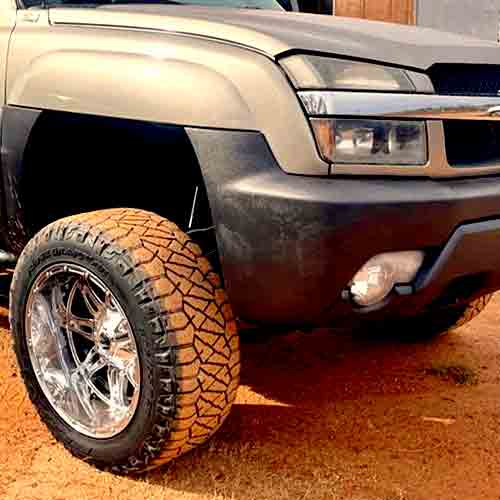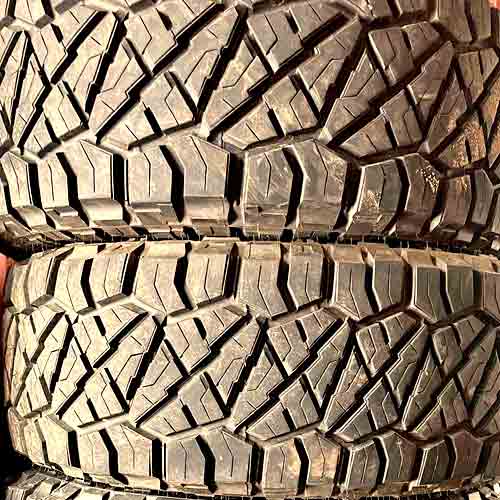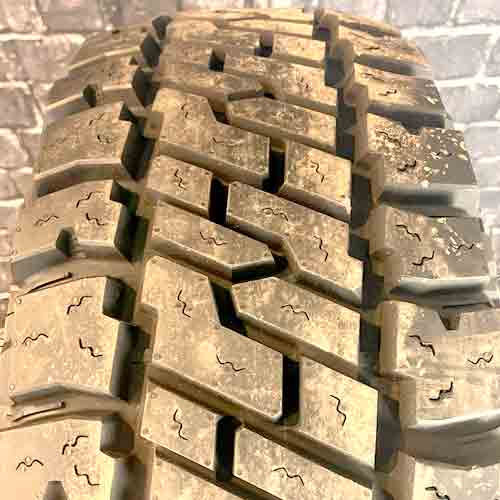Both the Mickey Thompson Baja Legend EXP and the Nitto Ridge Grappler are two beasts, built for trucks and full sized SUVs, but don’t let their size hold you back, they are just as great on smooth pavements as well. Though these tires do get to be slightly better over the other when you get to see the niched down performance areas. Let’s check them out.

Being a tire engineer, from my perspective, the Nitto Ridge Grappler has although on par dry and wet traction (almost), the tire yields better results when it comes to fuel economy, ride quietness, and traction on snow and rocks. On the other side, the Mickey Thompson Baja Legend EXP supplies better mud and sand traction, along with longer tread life, and on/off-road comfort.
Table of Contents
Tire Sizes
The Nitto Ridge Grappler offers 98 total sizes, in 16 to 24 inches, with following specs:
- Load ratings available: SL, XL, D, E and F.
- Speed ratings available: T or Q.
- Weight range : 36 lbs to 91 lbs.
- Tread depth range: 13/32″ to 18/32″ (Most common: 16.4/32″).
- Sizes have no mileage warranty or 3PMSFR.
- Comes with 3 ply polyester, 2 steel belts and 2 ply nylon.
On the other side, the Mickey Thompson Baja Legend EXP features 41 sizes in 15 to 20 inches having following specs:
- Speed ratings: Q only.
- Load ratings: C, D, E and F.
- Weight range: 45 to 75 lbs.
- Tread depth: 18.5/32″ on all.
- 50k miles warranty on all sizes.
- No winter rating is seen on any.
- Comes with 2 ply polyester, rest is same as Ridge Grappler.
Tread Structure
The Nitto Ridge Grappler features a more aggressive tread pattern, overall, in comparison.

The tire provides you with four (triangularly shaped) lugs in the middle, where you can see the two lugs with notches facing the grooves of the shoulders. And the other two, with razor blade edges, offset sides and full depth sipes.
All of these features combined provide strong gripping capabilities on all types of rugged terrains.
Yet, the tire is also pretty good on pavements, as as lugs have secondary rubber layers underneath, disallowing them to bend/flex too much, which enhances on-road stability.
Moreover, all these blocks create a Z/X shaped grooves that connects to the outer zigzag longitudinal channels, offering efficient self-cleaning.
Moving towards the outer ribs, there are less aggressive lugs (compared to those in the middle). They although have bold stone ejectors in wide gaps they make, they are missing with any kind of notches or off-set edges.
So does that mean they are less biting off-road? Well not really, as the outer edges of the tire has staggered margins, and that combined with thicker sidewall lugs on both sides of different proportions (as you get dual pattern with this tire), you get to have plenty of traction off-road.
On the other side, the Mickey Thompson Baja Legend EXP, coming in the same category of rugged-terrain tires, is also pretty aggressive.

Let me start form the middle.
Here, the tire features 2 ribs, making mirror images of each other.
They although have pretty closed up blocks formation, having sharp edges (chamfered), and full depth “M” shaped sipes, they still make an interconnecting map of grooves connecting the outer wider circumferential channels.
Though the widest grooves are seen between the shoulder blocks.
Speaking of which, these shoulder lugs are bulkier and have full depth notches, though have similar “M” shaped siping on them as well.
And their outer margins are very biting, as they feature staggered shoulder lugs and join with thick “enough” sidewall lugs providing off-road bite.
Dry Traction
In case of these tires dry traction is a little complicated to explain. That’s because one tire excels in directional grip, while the other renders better lateral efficacy.
The directional grip depend on the central part of the tread, and here the Mickey Thompson Baja Legend EXP with longitudinal orientation of the lugs, and minimal tread features, provide better contact with the ground (while moving straight).
While on corners, where shoulders (exposure with the ground) is important, the Nitto Ridge Grappler provides better traction values, with it’s narrower lateral gaps, and a more solid construction of the lugs, which provide superior steering response.
Wet Traction
The successful execution of wet traction is contingent upon two principal elements: wet grip and hydroplaning resistance. Let me discuss them both.
Hydroplaning
When a tire is not able to clear water off form it’s tread (in time), a thin layer of it, comes in between the tire and the ground, and this causes floating, or “hydroplaning”, (also called aquaplaning).
So it makes sense why speed is the main culprit here, and why this performance metric gets measured with float speeds (how fast a tire can go, without floating).
Though as both tires are limited by their speed ratings, you still see a better capability on Mickey Thompson Baja Legend. This is because the tire for one, has wider grooves, and two, provides softer compound that allows its lugs to flex (more), creating negative pressure for the water, so it can be gushed out with greater force.
Nitto Ridge Grappler on the other hand, is although not going to feel any different here, subjectively, it’s float speeds are marginally lacking. So on the paper, it still falls short (during my real world testing with these tires).
Wet Grip
As most of the water gets expelled out with the help of grooves, the left over, comes directly in contact with the tread blocks. And if it weren’t for the sipes, a tire would slip.
These sipes are basically tiny slits in the tread, and they expels out the air, whilst meeting with the road, creating vacuum, which soaks up the water particles.
Now here’s the dilemma.
The Mickey Thompson EXP although has a softer compound providing ample flexing abilities to its sipes, there aren’t too many sipes to begin with, and even those have very tiny gaps in them, so they’re not sufficient for good enough water removal.
Whereas the Nitto Ridge Grappler, although has a lot more sipes, they are only rectilinear, which means they would get stiffer as the tire corners, and brakes, and the harder compound of the tread is not helping it either.
That’s why upon testing, I rated both tires equal here.
Fuel Usage
Fuel usage depends on the tire’s weight and tread structure, and considering both, it can be explained why you get a similar economy on both tires.
The Mickey Thompson Baja EXP with it’s softer compound, and more tread depth (on average), causes its lugs to flex more. This consumes energy, which gets wasted in to deforming of the tire, bringing it’s fuel efficiency down, even tough the tire is significantly lighter (out of both).
Though that does not mean the Nitto Ridge Grappler does a better job here. But why is that?
Well, because this tire too, loses about the same amount of fuel in to carrying it’s heavier weight. So where you have more stability (of the tread blocks), its heavier structure brings down fuel economy to the same levels as that of Baja EXP.
Ride Quality
The two most significant factors in determining ride quality are the noise generated by the tire tread and its capacity to mitigate road imperfections through its structure and tread composition. Let me examine each in more detail.
Tread Noise
The generation of tire noise comes from air flow, mostly through the grooves in the outer ribs of the tire’s tread, resulting in air particles striking the voids (of the blocks) and producing unwanted sound.
That’s why, out of the two tires, with a balder shoulders, the Mickey Thompson Baja Legend EXP gets to be louder.
Nitto Ridge Grappler on the other side, doesn’t not allow too much air to flow inwards, in the first place, and it further dampens its noise levels down with the help of pitch sequencing.
It’s tread blocks vary a lot in geometry, and this causes the noise (from air particles hitting the lugs), to get generated in a wide spectrum of different pitches and tones. And they don’t get to sync together and amplify.
Are All-Terrain Tires Noisy? : https://tiredriver.com/are-all-terrain-tires-noisy/
On-Road Vibrations
Mickey Thompson Baja Legend EXP is although louder, it’s still not that bad in the overall comfort department, thanks to it’s pliable tread blocks.
They account for a better absorption of the shocks on-road, while the greater tread depth provide the area for the bumps to settle down before reaching the driver
Nitto Ridge Grappler on the other side, is although more stable on highways, can’t not settle down the vibrations with as much effectiveness with it’s stiffer composition.
Winter Traction
With Mickey Thompson Baja Legend EXP severely lacking in providing ample sipes, its no wonder why the tire is so poor, when it comes to winter performance.
On the other hand, the Nitto Ridge Grappler provides multiple biters which grab and hold on to the snow particles and make snow contact with them (which creates better friction instead of rubber to snow contact).
Snowflakes basically have unique arms which tie with each other, so they stick better on other snowflakes, that’s why we have the phrase, the snowball effect.
Off Road Traction
The challenges posed by off-road terrains can vary greatly, from mud to gravel, sand and rocks. Let’s check them all out and see how both of these boys perform on them.
Mud Performance
Mud is although pretty tough for all-terrain tires, its still handled pretty well when it comes to these two, coming in rugged terrain category.
That’s because these hybrids, have shoulder lugs of mud-terrain tires. (See all types of off-road tires here).
And with such wide shoulder grooves, and thick lugs, they easily allow the slushy clay to leave out of thread asap.
Though out of both tires, the Mickey Thompson Baja Legend EXP still does a better job, as it shoulder lugs are more voided for one, and they allow better scooping with their staggered edges.
Nitto Ridge Grappler on the other side, is also not so bad here as well, but its slightly closed up lugs still don’t render similar results.
Rock Climbing
To drive effectively on rocky terrains, you need a tire with a soft tread that can bend and flex for improved traction, and a strong grip in all directions to avoid slipping. Additionally, the tire must also have durable sidewalls to resist sharp punctures.
And so considering all, the Mickey Thompson Baja Legend EXP although provides bigger groove mouth, its really lacks in providing ample biters, as you see a very blocky design, without any kind of notches.
That’s why overall you get a better traction on Nitto Ridge, where the tire features more biters which stick to the rocky surface like a magnet.
Desert Performance
Sand driving can be made easier with a tire that has the following:
- It should have a softer tread.
- It should have a greater section width on average.
- And it should provide paddling.
And considering all it makes sense why the Mickey Thompson Baja Legend EXP is a better suited tire here, on both lighter and deeper terrains.
It’s tread is softer, and its overall construction is much lighter in comparison, both of these avoid digging, whereas its thicker shoulders with sidewall lugs pasted on a larger surface area, yield paddling/scooping, (with lowered air pressure), throwing sand backwards and generating forward motion with it.
Nitto Ridge Grappler on the other side, is more susceptible to digging. It’s outer edges are sharper, and with stiffer compound composition, they tend to sink more, when you take these tires on deeper terrains.
Though with further lowering of air pressure, the tire’s dual sidewall lugs, provide decent traction values overall.
My Guide on Air Pressure on all terrains: https://tiredriver.com/air-pressure-guide-for-all-terrain-tires/
Gravely Roads
To ensure a reliable off-roading experience on gravely roads, it’s crucial to have tires with self-cleaning grooves.
That’s why with a softer compound, and wider tread voids (comparatively), the Mickey Legend EXP renders better traction values.
On dirt filled roads, you have to avoid stones, and dirt particles form clogging in to the tread, as this hinders the overall traction, and also hurts the tire, even though most off-road tires are equipped with a cut resistant rubber.
Having said that, the Nitto Ridge Grappler is more inviting of the dirt particles, in it’s closed up lugs especially on the shoulders, and it’s stone ejectors are not as bold as the Mickey EXP. That’s why it shows lacking performance here overall.
Though the difference is very marginal (only half a feet longer braking distance is seen on Nitto Ridge).
In closing
Out of both tires, the Mickey Thompson EXP yields better results when it comes to mud and sand traction, it features longer tread life, and you’d get better comfort on roads as well, here.
On the other hand, the Ridge Grappler provides superior rock and snow grip, a quieter ride, and a better fuel economy.
Other than this, both tires have similar traction values on both dry and wet roads (well, there’s more to it, as I’ve explained, but for sake of summarizing, it can be said).
Thanks for a great comparison article. Most times writers are too reserved to say one is better than another. Their articles are a waste of reading time as they usually close with “these are both great buys and it really depends on which appeals to you the most.”
Thank you for the kind words, Roy. I believe it’s important to provide clear and actionable information to the reader, so I always strive to make a definitive recommendation when one product is superior to another. I’m glad you found the article helpful!